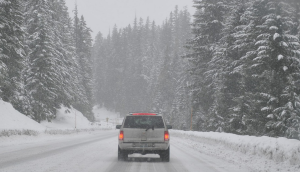Winter weather can wreak all kinds of internal and external damage to an unprotected car. Freezing temperatures can harm tires, batteries, windshield wipers, motor oil, coolant, and more. And the salty snow from gritted roads rapidly corrodes paintwork and exposed metal parts. If you’re worried about cold weather in Silver Spring, MD this winter, use the following seven methods to keep your vehicle safe from harm.
Check Tire Pressure Often
For every 10-degree drop in temperature, tire pressure falls by one pound per square inch. Driving with under-inflated tires is dangerous because too much rubber comes into contact with the road.

This excessive contact causes wear and tear and also overheating inside the tire, which puts the tire at risk of a blowout. To mitigate this danger, check your tire pressure more frequently during winter and keep your tire inflator close at hand.
Take Care Where You Park
Most winter damage happens overnight when your vehicle is parked. Sub-zero temperatures can cause your battery to die, engine oil to thicken, and coolant to freeze. Any snow on the car will exacerbate these problems, cause rusting, and even damage your braking and exhaust systems.
Beware when parking under trees, which might deposit snow on your car overnight. Also, try to avoid parking on the street. Passing vehicles can spray your car’s bodywork with gritty snow.
Protect Your Car With a Cover
The best defense against winter weather, outside of a garage, is to use a good car cover. A cover will keep snow and grit away from your vehicle. Using an insulating cover will also reduce the freezing effect of low temperatures on the internal parts of your car.
Wash Your Car Frequently
It’s advisable to wash your car more often during winter or at least brush it down with a good snow brush. Clean the snow and grit away from the bodywork. Also, clean snow from your exhaust pipe, undercarriage, windshield wipers, windows, lights, mirrors, and external cameras.
Use Appropriate Winter Coolant
It’s essential to change your coolant as winter approaches. You’ll need a special synthetic coolant with antifreeze properties to resist freezing temperatures. If you’re unsure which coolant to use, you can always ask at your local dealership.
Wax Your Bodywork Well
An extra layer of paint sealant or synthetic wax will help protect your clearcoat and paintwork from grit and snow. Apply this layer of sealant or wax before the first snowfall sets in.
Install Winter Tires
While winterizing your car, don’t forget to install winter tires. These tires are far better suited to handling icy road surfaces. With winter tires, you’ll have greater stopping power, and you’re less likely to go into an unexpected skid.
Snowfall in Silver Spring, MD
Fortunately, Silver Spring only sees about 14 inches of snowfall on average each year. This is half the national average of 28 inches. But Silver Spring’s snow and cold are still enough to cause damage to unprotected vehicles.
We hope our DARCARS Lexus of Silver Spring blog comes in handy this winter season when the roads get difficult to manage. If you’d like to continue reading, we suggest checking out our 5 tips for navigating your car in snow today!
Image by Pixabay




